
ACCELERATING BUSINESS
TAKING FLIGHT
EPPLEY AIRFIELD’S GRAND EXPANSION









































EPPLEY AIRFIELD’S GRAND EXPANSION







































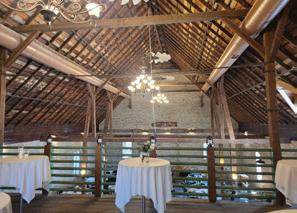



Berkshire Hathaway HS
Ambassador Real Estate- Commercial Division
331 Village Pointe Plaza, Omaha NE 68118
BHHSAmbCommercial.com | 402.547.5064
EXECUTIVE
publisher
Todd Lemke
associate publisher
Bill Sitzmann
EDITORIAL
editor-in-chief
Kim Carpenter
associate editor
Natalie Veloso
assignment editor
Claudia Moomey
senior staff writer
Julius Fredrick
contributors
Tamsen Butler
Dwain Hebda
Holly McAtee
Natalie McGovern
Heath Mello
Steve Jordon
Kara Schweiss
Deborah Ward
INFORMATION advertising information 402.884.2000



subscribe online omahamagazine.com/ pages/subscribe
B2B Magazine is published six times annually by Omaha Magazine, LTD, P.O. Box 461208, Omaha NE 68046-1208. Telephone: 402.884.2000; fax 402.884.2001. Subscription rates: $12.95 for 4 issues (one year), $19.95 for 8 issues (two years). Multiple subscriptions at different rates are available. No whole or part of the contents herein may be reproduced without prior written permission of B2B Omaha Magazine, excepting individually copyrighted articles and photographs. Unsolicited manuscripts are accepted, however no responsibility will be assumed for such solicitations.
creative director
Rachel Birdsall
sr. graphic designer
Renee Ludwick
graphic designer II
Nickie Robinson
graphic designer I
Joey Winton
photographers
Katie Anderson
Scott Drickey
photo editor
Sarah Lemke
SALES
executive vice president
sales & marketing
Gil Cohen
branding specialists
Dawn Dennis
George Idelman
Francine Flegg
contributing branding
specialists
Greg Bruns
Tim McCormack
assistant to the publisher
Sandy Matson
senior sales coordinator
Alicia Hollins
sales coordinator
Sandi McCormack
OPERATIONS
business manager
Kyle Fisher
ad traffic manager
David Trouba
digital manager
Luis De la Toba
distribution manager
Damian Ingersoll
I n March of this year, Forbes Home ranked “The Best Cities to Move to in 2024.” It’s no surprise to us that out of 15, Omaha ranked #1, ahead of metropolises like Raleigh, North Carolina; Colorado Springs, Colorado; Virginia Beach, Virginia; and Austin, Texas. According to Forbes’ research, Omaha scored a perfect 100 thanks in part to “an impressive 98% employment rate, emphasizing the city’s strong job market and abundant opportunities for those who value career advancement.”
Omaha is, in sum, an excellent place to do business. That’s why companies like HDR, a design and engineering firm with 200 offices around the globe and more than 12,000 employees worldwide, chooses to keep its headquarters here. Read our exclusive interview with HDR CEO John Henderson for his insights into what it’s like running a 100% employeeowned company and his commitment to attracting and retaining top-tier talent.
Veteran business writer Steve Jordon also provides a breakdown of what’s in store for Omaha businesses legislatively. From childcare to industrial sites, the Nebraska Unicameral’s 2024 session means growth for state businesses. Whether you’re a small business owner or a global company, you can anticipate changes that will positively impact your bottom line.
Of course, there are other ways to affect profitability, one often not considered: brain science. The BrainWorks Institute, a new initiative by Heartland Family Service, employs scientific findings to help business leaders creative positive, productive workplaces and efficient teams. HFS President & CEO John Jeanetta and Director of Learning & Development Sonia Keffer discuss how understanding brain science can lead to big gains for businesses.
The articles in this issue underscore exactly why Omaha ranked #1 with Forbes Home. Our city “offers a solid combination of affordability, economic opportunity, enjoyable climate, employment opportunities, and safety.” This is exactly why we are “the overall winner.”
Kim Carpenter is editor-in-chief at Omaha Publications. She can be reached for story suggestions and pitches at kim@omahapublications.com



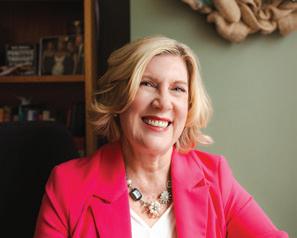
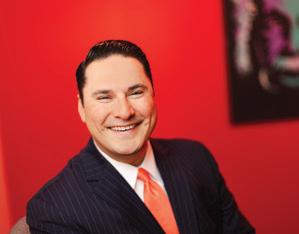

When John Henderson took the helm at HDR as the company’s new CEO, he brought dynamic leadership to the country’s largest employeeowned architecture and engineering firm. Read about his background steeped in service beginning on page 06. Cover photography Bill Sitzmann | Cover design Renee Ludwick
Formed in 1924, the Omaha Executives Association (OEA) celebrated their 100th anniversary on May 10. A networking group of business owners and executives, the OEA strives to “increase the sales of goods and services of its members through the exchange of business information, networking, and leads…the members share a common objective of improving sales, enhancing quality of service, and maintaining a market presence in the community.” With weekly meetings of company owners and decisionmakers and a new president every six months, Omaha Executives Association shows no signs of slowing down.
“These are business people who promote other business people,” said Barbara Kadrlik of the Kadsen Corporation, a member of the organization and chairperson of the 100th anniversary celebration event. “It’s a very serious organization; you can’t just join, you have to be sponsored in.” With one representative per business classification, the OEA meets every Thursday at the Field Club of Omaha to discuss business. “I look forward to the meetings every week,” Kadrlik shared. “Each member gets to stand up and speak about their business we make sure everyone is recognized.
“We’re also growing with a lot more women,” Kadrlik continued. “I’m a big proponent of supporting women in business.”
Lynne Mancuso, executive director for the OEA, is passionate about the organization’s resilience and dedication of its members. “It’s impressive to me that we’re not a monthly association; we meet weekly. For a weekly meeting to be happening for the last 100 years means a lot,” she said. “I
like to think of it more as a service group our members take care of each other.”
Even in uncertain times, the OEA has survived. “We met every week during COVID,” said Kadrlik, “but in-person is the way you get to know people. It’s a great cross-section of people laborers, lawyers, bankers, all different walks of life and I’m proud to be a member of an organization that’s lasted 100 years.”
Not only are networking connections formed, but friendships are developed among the current 88 members of OEA. “It’s a fantastic group; they’re wonderful people,” Mancuso said. “These people are all business owners, and they still take time out of their work days to attend the meetings every week. I’m very honored to be a part of this group and the be able to serve these members. The OEA has really helped make Omaha what is today.”
The phrase, “it’s not what you know, it’s who you know” rings true within the OEA. “We have 88 members right now,” said Mancuso. “That’s 88 business connections; there’s always a benefit out of the meetings.”
“It has been a blessing to be in this group, and my business has grown exponentially because of it,” Kadrlik reflected. “We’re like-minded people, and we have fun!”
To learn more, visit omahaexec.com.

“THESE PEOPLE ARE ALL BUSINESS OWNERS, AND THEY STILL TAKE TIME OUT OF THEIR WORK DAYS TO PRESIDE OVER THE MEETINGS EVERY WEEK. I’M VERY HONORED TO BE A PART OF THIS GROUP AND THE BE ABLE TO SERVE THESE MEMBERS. THE OEA HAS REALLY HELPED MAKE OMAHA WHAT IS TODAY.”
-LYNNE MANCUSO Left to right: Brent Wilson-Ambiance Audio/Control/Video, OEA current president Barbara Kadrlik-Kadsen Corporation, OEA chairperson Lynne Mancuso-OEA executive director David Cooke-JP Cooke, OEA founding member Pat Duesman-Chicago Lumber, OEA founding member
“IT’S ONE THING TO BE GOOD AT MATH AND SCIENCE, BUT THE REAL INNOVATIVE PART OF ENGINEERING IS THAT SENSE OF CREATIVITY THAT GOES WITH IT. THE INVENTION, INNOVATION— FINDING A SOLUTION TO A PROBLEM.”
-JOHN HENDERSON, CEO HDRThe pulse of a city rests not in the static, but the mutable where scaffolds and wrecking balls sway between the rhythms of supply and demand and vision and reality. Few sites in Omaha echo this more audibly than the tract of land from 50th to 72nd between Leavenworth and Center streets.
Sprung from the ill-fated blueprints of Franklin D. Roosevelt’s “model communities” initiative in the 1930s, utopia quickly turned to wasteland as the original ‘Aksarben City’ priced out prospective residents. Focus then shifted from residential to entertainment: crooning guitars, thundering hoof beats, and roaring crowds filled the void as the Ak-Sar-Ben Racetrack and Coliseum occupied the space for the remainder of the 20th century until it shuttered and was eventually demolished in 2005.
With this record in mind, Omaha city planners proposed a “mixed-use” development a patchwork of corporate, academic, recreational, culinary, and retail enterprise that promised stability vis-a-vis versatility.
In 2019, the Aksarben Village experiment won the ultimate peer endorsement, and the crown jewel of its business facades, with the addition of HDR’s 10-story global headquarters.
It’s from this uniquely chamfered base that HDR’s newly minted CEO, John Henderson himself a product of shifting trajectories and the requisite ingenuity to scale them oversees the country’s largest employee-owned architecture and engineering firm.
“I’m not surprised that the headquarters stayed here. We got stationed here with the military, and if you’ve lived in several other cities around the world, you just realize what a special place Omaha is,” said Henderson of where he and his family chose to settle after 16 moves. “It’s a well-run city and it’s a great community. It’s a great place to base your business out of.”
Exacting rationality and boundless imagination have guided HDR over the firm’s 107-year history, and the new CEO is no exception with the schematics of Henderson’s career having faced multiple, unexpected revisions with or without a drafting table. Growing up in the Black Hills of South Dakota, a young Henderson sought shortterm gains funds to continue his civil engineering studies at South Dakota School of Mines and Technology via a long-term commitment. That commitment, however, not only proved lengthier, but far more rewarding than he’d ever imagined.
“I needed money for college, so I intended to go into the military but only to do my four years of obligated service,” said Henderson, the flicker of a grin stoked by the memory. “And then I was going to get out, and I was going to come back to the Midwest and be an engineer. It took me an entire career to figure out how to do that.”
Henderson served six tours in the Asia-Pacific Region and five assignments with the U.S. Army Corps of Engineers, three of which found him in active combat zones. During his decades of service, he not only worked with “world class
people,” but also sharpened his leadership under spartan conditions. This culminated with a Battalion Commander post in 2013, directing the deployment of 1,000 troops in Afghanistan during the twilight years of ‘Operation Enduring Freedom.’
“In Afghanistan, we had 19 construction platoons, and we were working all over the country, consolidating and cleaning up bases,” Henderson said. “They might be a bulldozer operator or a carpenter, but when they get on the patrols to move, they self-secured […] they’re soldiers by night, carpenters by day. It’s a really fun group of people to work with.”
Retiring from his station as Commander of the Omaha District in 2017, nearly 24 years of decorated military service drew to a close. Henderson approached retirement with a mix of relief and apprehension, “throwing his name in the hat” for a political position behind tempered expectations. A call from Secretary of Defense James Mattis’ team swept any doubts away, and Henderson went into an altogether different type of battlefield: Washington D.C. Nominated for appointment by President Trump in 2017 and later confirmed by the Senate, Henderson assumed office as Assistant Secretary of the Air Force (Installations, Environment & Energy) and began weekly commutes from Omaha to the Pentagon.
“They’re growing experiences, right? And honestly, once you get to know the system, they’re less scary,” posited Henderson, recalling the handful of times he’d been called in for a committee hearing on Capitol Hill. “We see it through the lens of TV, but I know in the background a lot of these people actually get along pretty well […] They see things differently and they disagree, and by virtue get caught up in the rhetoric. But for the most part, they’re really good people that have the best interest of their constituents in mind.”
While the occasional congressional grill session provided Henderson a front row, if occasionally a blistering seat to legislative theater, it was behind the curtain where Henderson’s mettle was truly tested. In coordination with then Secretary of the Air Force Heather Wilson, Henderson directed operational and maintenance projects across 180 Air Force bases globally, an annual portfolio upwards of $15 billion.
When seeking appointees, Mattis had requested “people who know their business,” while Wilson said, “We want to put an engineer in there.” In each case, Henderson rose to the occasion, earning high praise from superiors and subordinates alike until the inevitable change of staff following President Biden’s inauguration.
“With the Corps of Engineers, with the Army construction units, I always just felt this immense pride in being a part of a profession that inherently does good and improves the quality of life for others,” Henderson reflected. “The circumstances were never part of the design I got to be a colonel in the military and got to command a great engineer district. But remember, my plan was to go into the military, do four years, and get out. But after a couple of combat tours, it’s almost like a calling. The military trains you to serve, and you develop a sense of duty to do that; I found a lot of professional satisfaction in that.
“The political appointment thing was a total fluke. It was a cold call out of nowhere; never even thought about doing that. And the opportunity to come to HDR was the same thing. It was the end of the administration, my family was here in Omaha, I was an engineer, and I just wanted to get back into my profession; I just wanted to do what I got into the profession to do. So, when I first started talking to Eric Keen, I said ‘I’d love to be a part of your company […] I could be a project manager for you, I could probably run a survey crew, I could sweep your floors. Really, I just want to be on a winning team.’”
Keen, HDR CEO from 2017 to 2024, had worked with Henderson client-side for years and was well acquainted with the retired colonel’s cool-headed leadership and engineering chops. In 2021, the latter began his HDR career as Senior Vice President and Chief Administrative Officer (CAO), quickly ascending to President and Chief Operating Officer (COO) in 2023. When Keen took on the role of executive chairman of HDR’s board of directors in 2024, Henderson was primed to assume the mantle.
“The more I’ve learned about leadership, the more I’ve realized how much I don’t know about leadership,” said Henderson, reflecting on his transition from military command hierarchy to the private sector. “But what I’ve learned is that the fundamental principles are the same: how leaders build strong teams, how they build trust in those teams, how they train those teams to perform well and in a consistent manner, how to build trust with the stakeholders. Those universal concepts of how to do that are the same in the military.
“Now, you have to articulate style […] if you’re in a combat situation, that requires very direct, very quick, concise leadership, because if you’re hesitating, people may get hurt or killed, as opposed to a more corporate setting like this, where you want to take some time and develop buy-in and look at different options to come up with solutions.”
Another similarity is the nature of the ‘stakeholders’ involved. With HDR 100% employee-owned via an employee stock ownership plan (ESOP), Henderson’s executive decisions have a ripple effect across the entire company not unlike a platoon of soldiers and strategic objectives, with no one left behind.
“The thing about working for a 100% employeeowned company, if you’re the CEO, you’re essentially working for all of your shareholders,” Henderson said. “And that means when we post the share price at the end of the year, everybody benefits from the same share price. That’s our way of returning the profits, the results of everybody’s hard work back to everybody in the company whether you’re a drafting professional or work in our mailroom, whether you’re an engineer there’s this great story about wealth equity across our company.”
Henderson believes this model has served HDR well in attracting and retaining top talent amid a tight labor market. He also believes the firm’s dedication to sustainability, backed by a LEED (Leadership in Energy and Environmental Design) certification, empowers employees and clients alike
when contracts hit the negotiating table. Recent projects testify to this standard, including the design and delivery of the world’s largest indoor hydronic vertical farm, Dubai’s 330,000-squarefoot ‘Bustanica’ facility. Henderson noted that such projects reflect “a great ecosystem with a lot of talented professionals,” from designers and engineers to builders and contractors. One particular “outside the process” partnership, however, stirs Henderson’s otherwise stoic demeanor with visible pride.
“In Jackson, Mississippi, you have a city that’s having a crisis, a water crisis, but underneath that, a crisis in trust,” said Henderson, recalling the 2022 flood and subsequent state of emergency that left 150,000 residents without potable water and HDR’s invitation to help revive the city’s neglected water infrastructure. “This is what we do we go in and help communities be better, provide safe drinking water, safe places to live and work, provide effective transportation networks. Especially in an economically depressed area like Jackson, we felt that with our purpose and aim that was the right thing to do […] there are two or three firms down there working the projects, and it’s going really well. And you know, as soon we signed up for that, we had volunteers from all over the company who wanted to be part of making something better leaving a legacy of trust in Jackson, Mississippi…”
With payroll exceeding nearly 13,000 individuals in more than 200 offices, such national and international success stories are business as usual. Still, with strong, 107-year-old roots in Omaha, HDR has had, and continues to have, a significant hand in shaping the city’s skyline including the College World Series’ home at Charles Schwab Field, Midtown Crossing, the revitalized Gene Leahy Mall, and most recently, the Kiewit Luminarium.
Though FDR’s New Deal ‘dream city’ may have never materialized, firms like HDR with dynamic individuals like Henderson at the helm are making up for lost time. In Omaha and abroad, yesterday’s ideals are becoming today’s realities, and the heartbeat of tomorrow’s breakthroughs.
“It’s one thing to be good at math and science, but the real innovative part of engineering is that sense of creativity that goes with it,” Henderson affirmed. “The invention, innovation finding a solution to a problem.”
For more information about HDR, visit hdrinc.com.








There’s no argument to be had: Our property taxes are bad. But what to do next has everyone vexed. Each answer makes somebody mad. Mike Holmes, Retired Statehouse Reporter.
Nebraska business advocates saw some wishes granted and others skipped by the 2024 Nebraska Legislature. Out of 17 proposals supported by local and state Chambers of Commerce, six won approval from the state’s 49 senators.
Business advocates say the state’s political leaders avoided public policy pitfalls rejecting two proposals that the business groups opposed and took positive steps in child care, attracting new workers and creating future sites for innovative new businesses.
The other 11 ideas?
Many will be back again next year as part of the longrange goal of making Nebraska an economic beacon for businesses and those who start and run them.
“Clearly, we have to bring people to the state and keep people in the state,” said Bryan Slone, president of the Nebraska Chamber of Commerce and Industry. “We’re trying to attract and support great companies and great jobs and technology and great people. That’s the key to our future.”
The Legislature, which met for 60 of the days between Jan. 3 and April 18, did its job, said Jennifer Creager, lobbyist for the Greater Omaha Chamber of Commerce. “Business is about getting things done and compromising, sending an important message to the state and the business community that they can rely on their elected officials to solve the problems at the end of the day.”
She’s not discouraged that many proposals failed. Taxation and other complex issues took up much of the time in this year’s session, leaving many proposals until the last minute.
“It’s a mad rush to the end,” Creager said. “On the one hand, that’s not the best way to make policy. But on the other hand, that’s just a reflection that things won’t move politically until there is that time pressure and the need to accomplish something. I think the senators take their responsibilities very seriously.”
The biggest proposal that didn’t pass: Gov. Jim Pillen’s effort to reduce local property taxes by limiting local government spending, raising the state sales tax rate and eliminating some sales tax exemptions.
The governor told the senators that property taxes are out of control and hurt farmers, ranchers, homeowners, and businesses “every Nebraskan in every part of our state.”
Chambers of Commerces in Lincoln, Kearney, Grand Island, and Washington County joined the Omaha and State Chambers in opposing the plan, along with some other business groups. Senators trimmed back the proposal during debate, but in the end it failed when the session expired without a vote, opening the way for a special session of the Legislature to deal with taxes.
“Everybody in this state would like to reduce property taxes,” Slone said. “The only question is, are we going to do it by creating economic growth, or are we going to have other taxpayers pay for it?
“You don’t create a perfect tax system in one year. We need to make our tax system very competitive with other states for people to want to work here, to bring in great companies and to continue to grow the great companies that we have in the state and
create opportunities. We’ve all got to be focused on that.”
The Chambers especially disagreed with a plan to start taxing advertising on large internet platforms, which Slone said would create a cost disadvantage for Nebraska businesses. A similar law in Maryland is in limbo, blocked by lawsuits alleging that it’s discriminatory to tax some businesses but not others.
Aside from the tax issues, contained in Pillen’s Legislative Bill 388, business groups said these new laws, which started as “LBs,” can benefit the state’s businesses and the people who work here.
LB 856 makes child care workers eligible for a federal program to pay for child care for their own children. The Legislature passed the measure to enact the program but deleted $10 million to fund it.
Creager said the program is aimed at attracting more child care workers by covering their own child care costs while they care for others’ children. The shortage of child care workers affects all working parents.
“I had two kids in child care, so I get it,” she said. “If the care center calls in the morning and says they can only take 10 kids instead of 14 and could four of you stay home, that’s a very difficult thing to deal with. You need a stable child care environment.”
Losing the $10 million will lessen the law’s impact, Slone said, but at least the program can start. “We’ll definitely want to continue with the funding. We’ll be talking child care for the next five years.”
The senators also enacted LB 874 to simplify child care licensing.

“NEBRASKA BUSINESS ADVOCATES SAW SOME WISHES GRANTED AND OTHERS SKIPPED BY THE 2024 NEBRASKA LEGISLATURE. OUT OF 17 PROPOSALS SUPPORTED BY LOCAL AND STATE CHAMBERS OF COMMERCE, SIX WON APPROVAL FROM THE STATE’S 49 SENATORS.”
-STEVE JORDON, BUSINESS REPORTER
Jordon Steve
Steve
LB 1023, the Relocation Incentive Act, minimizes “double taxation” of people, especially remote workers, who earn income in more than one state. Nebraska is one of few states that still has such double taxes, along with Connecticut, Delaware, New York, and Pennsylvania.
The State Chamber said the idea is to help businesses compete for those workers, given that Nebraska usually has between 50,000 and 80,000 job openings. The law has other provisions, such as deductions for expenses for people who move to the state.
The law also will speed businesses tax deductions for investments in equipment, research, and development.
LB 937 provides a series of tax credits, including for those who care for elderly or disabled family members and those who serve, support, and hire people with developmental disabilities, and for making movies in Nebraska.
LB 644 originally proposed spending $160 million to develop industrial “mega-sites” 500 acres or larger. As passed, the law sets aside $500,000 to study site locations, demand, and funding for such sites, with the idea of bringing a spending proposal in 2025. The study will make sure the sites are properly carried out, Slone said.
LB 164 moves ahead a plan to develop an inland port authority an industrial development park controlled by an independent government board in a north Omaha area close to Eppley Airfield. The port authority can sell bonds, acquire property, and market the area for economic development.
“The inland port authority is an opportunity to develop a large site in an area of the city where that’s been a challenge in the past,” Creager said. “Developing a site is always a precursor to employment opportunity.”
The inland port proposal has drawn criticism from people living in the area because the authority
can buy privately owned land. In response, the senators added a requirement for public hearings and a citizen advisory committee to take public opinion into account.
Aside from enacting those six laws, the Legislature handled other business-related issues. The senators turned down a Pillen proposal for a series of changes in the state’s incentives for businesses that invest in Nebraska and create new jobs.
Creager said the current complex system of incentives was revised in 2020 after an extensive review that involved many business and government groups. That revision was supposed to have a 10-year “shelf life.”
She said it’s reasonable for a new governor Pillen took office in 2023 to have his own ideas.
“We may see him wanting to continue working in this space next year or for several years. It would help to involve some of those economic development professionals and experts if we do look at the program as a whole next session. We’d like to be part of that conversation.”
On another issue, as part of its tax plan the governor’s office had proposed using $70 million from the state’s unemployment trust fund for property tax relief. Employers had paid in the money voluntarily to backstop federal unemployment benefits in case of an economic downturn.
The Omaha, Lincoln, and State Chambers opposed the transfer, saying the state shouldn’t use that money for non-unemployment purposes. In a compromise, the Legislature sent $30 million toward property tax relief and $40 million to a new workforce development cash fund at the State Department of Labor. Employers were given a fiveyear break from paying into the fund.
The Legislature didn’t directly address another of the Chamber priorities: the state’s housing shortage, which discourages some people from coming to Nebraska or staying in the state. One proposal, LB 1166, would have required zoning rules so people could add “auxiliary” houses to their existing property. The measure died in the Urban Affairs Committee.
Housing has been a long-standing problem in rural areas where there are fewer builders and higher costs. Creager said the housing shortage is becoming more critical in Omaha and Lincoln, too.
“It’s a perpetual issue, for sure,” she said.
Overall, Creager and Sloan said, business interests’ long-term “bread and butter” goals remain.
Among them:
Attracting and retaining people between 18 and 34.
Encouraging entrepreneurs, innovation, research and development.
Balancing growth among important business and industry sectors.
Establishing a competitive tax system.
Protecting pro-business laws and policies.
Tackling those issues means advocating for business with the state’s policymakers, Creager said.
“Some of it is an internal assessment of how we want to go forward next year or the next five years or the next 10 years,” she said. “There’s also an assessment of the external climate coming from other senators, what’s coming from other organizations, what’s coming from the administration, and then determining how to partner with them or respond to the bills and policies in a way that best represents our membership.”
In a statement on public policy, the State Chamber says Nebraska must “transcend politics and geography to accelerate our state…We must continue to keep our foot on the gas.”
For more information, visit nebraskalegislature.gov.

“WE CAN’T JUST SIMPLY TELL PEOPLE TO CALM DOWN OR TRY TO RATIONALIZE WITH THEM, BECAUSE THAT PART OF THE BRAIN IS ‘OFFLINE.’ WE AS LEADERS CAN LEARN HOW TO HELP PEOPLE AND OURSELVES BE ABLE TO LET THAT ADRENALINE WORK ITS WAY THROUGH AND RECONNECT THAT HIGHER BRAIN BACK IN.”
-SONIA KEFFER, DIRECTOR OF LEARNING & DEVELOPMENT AT HEARTLAND FAMILY SERVICEThe community knows Heartland Family Service as a nonprofit that provides advocacy, education, and counseling and support services through three primary program areas: child and family well-being; counseling and prevention; and housing, safety, and financial stability. So, what’s the connection between HFS and the BrainWorks Institute, a new initiative rooted in human brain science that will primarily be serving workplaces?
“It’s structured to be almost like a social enterprise within our organization,” said John Jeanetta, President & CEO of Heartland Family Service.
BrainWorks Institute started in the aftermath of the COVID-19 pandemic.“We were hearing over and over again from different people in our community about what a struggle it has been, since the pandemic, with employees unable to manage their emotions like people having a super-short fuse, people just resigning and leaving, things coming up in the workplace they had just never seen before,” Jeanetta explained. “So, there’s this real sense of overwhelm coming from lots of different directions related to the pandemic and all the things that happened around that time.”
Since HFS team members serve people in crisis, the organization has developed many best-practice tools over time to help employees manage their emotional responses and understand clients better.
“In our business, if our employees aren’t supergrounded, our clients aren’t going to get the service that they need,” Jeanetta said. “We don’t have very long to prove to them that we are going to provide a safe space for them.”
Accordingly, HFS considered how to apply their processes to other organizations. “We realized that we have something to offer, and we could take some of the training that we do internally and make some changes, make it more universal for any kind of a business setting,” Jeanetta said. “[We can] bring that information to places that haven’t had the chance to hear it yet and make sure it’s grounded in research, especially brain science, because that research has really proliferated in the last few years.”
Sonia Keffer, Director of Learning & Development for HFS, said the BrainWorks Institute incorporates brain science research such as the SCARF model created by David Rock, author of “Your Brain at Work” and co-founder of the NeuroLeadership Institute, which uses neuroscience to understand individuals’ motivations and helps groups work more effectively together. The acronym represents “Status, Certainty, Autonomy, Relatedness, and Fairness.”
“We also share some pieces of a program called ‘C3 De-escalation’ training that was created by Andra Medea out of Chicago,” Keffer said. “A big part of what that research tells us comes from Dr. Amy Arnsten from Yale. She’s the preeminent prefrontal cortex researcher at Yale right now. She discovered, along with the work of John Gottman, that when we escalate or when we feel triggered in some way, we flood our brain with adrenaline.”
The chemical process then interferes with how people process information and respond, Keffer said. “We can’t just simply tell people to calm down or try to rationalize with them, because that part of the brain is ‘offline.’ We as leaders can learn how to help people and ourselves be able to let that adrenaline work its way through and reconnect that higher brain back in,” she said.
Keffer explained that other brain science research is also being incorporated into BrainWorks Institute programming. “We have people in the agency that are trained in other things [that] we can offer organizations.”
Matthew Cade’s company, Rebellion Fabrication, is a metal fabricator based in Wahoo, Nebraska. It serves general contractors, large fabricators, and architects and engineers throughout the country. Cade, whose role includes managing employees and holding them accountable, said he attended BrainWorks Institute pilot training earlier this year in the interest of becoming a better leader and motivator.
“Understanding the right way to communicate helps build the right culture. It helps align everybody to know that, as a leader, I care about them individually and I’m willing to invest in them,” he said. “At Rebellion, we say everybody in the company needs to feel three things: For us to win, they need to feel a part of something bigger, which is the vision for the company. They need to feel consistently appreciated for what they do, which means they’re in the right seat and they’re given the opportunity to be successful. And they need to have a voice that matters. BrainWorks kind of takes that and creates those opportunities for the right conversations… communicating one way to one person is not heard the same way to another person.”
While BrainWorks Institute training is sciencebased, the HFS team is also working to make it accessible and practical, Keffer said. The current vision involves presenting the program in four half-day components including an introductory session that can stand alone.
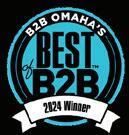




“WE REALIZED THAT WE HAVE SOMETHING TO OFFER, AND WE COULD TAKE SOME OF THE TRAINING THAT WE DO INTERNALLY AND MAKE SOME CHANGES, MAKE IT MORE UNIVERSAL FOR ANY KIND OF A BUSINESS SETTING. (WE CAN) BRING THAT INFORMATION TO PLACES THAT HAVEN’T HAD THE CHANCE TO HEAR IT YET, AND MAKE SURE IT’S GROUNDED IN RESEARCH—ESPECIALLY BRAIN SCIENCE, BECAUSE THAT RESEARCH HAS REALLY PROLIFERATED IN THE LAST FEW YEARS.”
-JOHN JEANETTA, PRESIDENT & CEO OF HEARTLAND FAMILY SERVICE
“It’s not like attending a huge college course,” she said. “I think of this training very much as some things that maybe someone is already doing, but doesn’t know why they work. And what are some things they can keep in mind, especially around psychological safety, that they may have been hearing about but are not quite sure how it pertains to themselves as a leader? Anyone can attend this training, and you will ‘get it.’ You will leave with tools that you can use that day.”
For more information, contact John Jeanetta at heartlandfamilyservice.org.
B2B









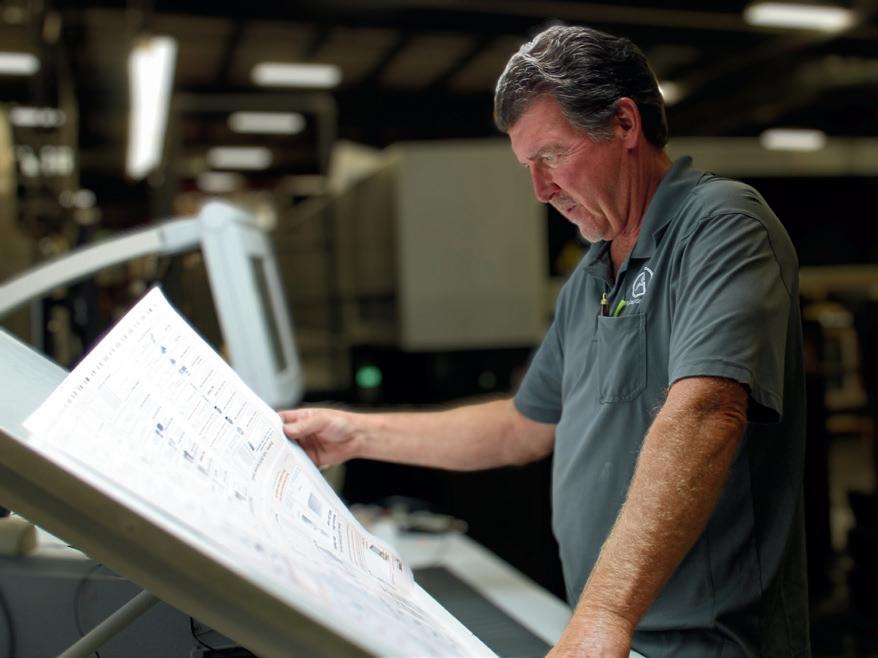
Omaha has never quite been comfortable with the label “boom town,” a term incongruous with the city’s steady-asshe-goes Midwestern jib of building something that lasts, brick by brick. But one glance at what gleams downtown, and the many things being built and improved throughout the community reveal a larger truth about the city’s unprecedented growth and development, stretching back at least three decades.
The recently announced expansion of Eppley Airfield’s terminal is particularly rife with possibilities for the city’s future. Not only airport officials, but leaders within the business, tourism, and political realms are also enthused about what the improvements will mean for their respective agendas boosting visitors, spurring new business, attracting new residents, and burnishing Omaha’s brand as the city you don’t expect.
“I like to say to people that Eppley is a place for first impressions and welcome-backs,” said Mayor Jean Stothert. “It’s where visitors first see the friendly spirit of Omaha and our people. I think it’s so important that what we’re doing with the new terminal reflects the needs of today’s travelers while providing flexibility to continue and to grow and expand in the long term.”
Some projects dazzle with the shine of something new or the scope of the cost, and Eppley’s terminal expansion is no exception, but look deeper and the underpinnings of the project are even more exciting. The airport isn’t struggling when it comes to traffic, coming off its second-busiest year ever in 2023, when it welcomed 5 million passengers. This underscores the improvements as being as much about efficiently and comfortably handling current traffic as creating elbow room for the future.
“When the project is done in 2028, it’s going to look and feel unlike anything we have had here at Eppley Airfield,” said Steve McCoy, chief information and development officer for the Omaha Airport Authority (OAA). “Not only are we going to be growing in space, adding new amenities, and having a more efficient experience that caters to both business and leisure travelers, it’s just going to be a total transformation for the passenger experience.
“We’re not just building it for the sake of building it; we’re building it based on a level of demand and need for air transportation here in Omaha. It’s not only going to meet the needs of today, but it’s going to set the airport up so that it can continue to grow and meet long-term travel needs here in Omaha and really set up Eppley Airfield for decades to come.”
Deborah Ward, executive director of Visit Omaha, the city’s official tourism authority, said the ambitious project represents a well-placed investment.
“Omaha’s airport is a huge selling point when we try to recruit convention and event business to our city,” she said. “Meeting event organizers love the fact that our airport is easy to navigate, we’re just four miles from the downtown convention center, and you can usually get to Omaha in two to three hours from about anywhere in the country. The airport expansion adds to all of the major developments happening to our city; from a tourism perspective, we have a whole new city to sell to convention event planners and the airport expansion is a huge piece of that.”
The improvements are also expected to play a wider role in the continuing effort to brand Omaha, expanding its image beyond college baseball, Warren Buffett, beef, and a zoo.
“I think we’re growing a reputation as a cultural oasis on the plains,” Ward said. “We surprise people; we’re still a young convention city. We’ve only been doing conventions and events at a really high level for 20 years. That’s really young. The airport expansion, adding significant traveler amenities and two international gates, really helps sell Omaha’s story.”
It’s been just shy of a century since 200 acquired acres on the haunches of the Missouri River began serving Omaha under the utilitarian moniker Municipal Landing Field. From the start, management of the asset was practical with improvements coming along only when needed. The first terminal, for example, wouldn’t be built for almost a decade when the facility was known as American Legion Municipal Airport.
Recognizing Omaha’s ideal positioning as a prime stopover location serving the postwar surge in cross-country flights, the airport enjoyed major expansion to handle growing demand, which hit 40 flights per day by the late 1950s. In 1960, the facility was renamed Eppley Airfield after hotel mogul and former barnstormer Eugene Eppley, whose foundation donated $1 million to the airport by which a new terminal was built and runways extended to handle jets in 1961.
It goes without saying even a visionary such as Eppley and city leaders of the day could scarcely imagine what the amenity would grow into 2,650 acres, about 70 daily departures by 8 carriers, including 31 non-stop destination airports or the scope of the passenger improvements to come.

“THIS KIND OF INVESTMENT BY THE AIRPORT AUTHORITY UNDERSCORES OMAHA’S COMMITMENT TO COLLECTIVE PROGRESS AND A BELIEF IN ITS FUTURE.”
-HEATH MELLO, PRESIDENT AND CEO OF GREATER OMAHA CHAMBER

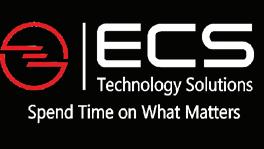





“The current terminal was redeveloped in the mid ’80s,” McCoy said. “A lot of the passenger processing functions of the airport predate the modern travel experience and the modern traveler’s expectations, as well as predating 9/11 security considerations. Those are all things that are being taken into consideration with this new development.”
Those improvements, spelled out via the project’s announcement in January, include the creation of a single, unified concourse expanded from 375,000 square feet to about 646,000 square feet with enhanced TSA operations. Arrival/ departure gates will expand to 22, including two for international flights with accompanying Customs and Border Protection arrivals halls for international passenger processing. Additional retail/restaurant space, enhanced accessibility, and improved people movement inside the terminal round out the forthcoming $950-million worth of terminal improvements.
Arguably as impressive as the size of the project is how it’s being paid for, McCoy said. As a nontaxing authority, OAA doesn’t collect local or state tax funds and is paying for the improvements through a combination of user fees, airport revenues, future airport bonds, and federal grants. The organization has been busy on the latter point, landing a $5.37-million federal grant in January to help build the $65-million all-weather canopy currently being installed over the terminal drive, a project separate to the other improvements. In March, an additional $7-million federal grant was announced, to be applied to the terminal project itself.
“This kind of investment by the airport authority underscores Omaha’s commitment to collective progress and a belief in its future,” said Heath Mello, president and CEO of Greater Omaha Chamber. “This substantial investment reflects a shared vision for growth and the community’s confidence in enhancing the city’s appeal.”
Mello described the improvements as a game-changer both in the recruitment and expansion of businesses as well as a powerful lure for permanent residents.
“Eppley Airfield’s role in attracting new businesses to Omaha is pivotal; it acts as a critical infrastructural node that offers connectivity and accessibility,” he said. “As the airport undergoes improvements, it will provide enhanced services and facilities, presenting Omaha as a forward-thinking city that is connected and values growth. The airport modernization project will assure prospective companies of a supportive environment for logistics and travel, essential factors in today’s globalized business landscape.
“Airport upgrades are also vital in attracting residents to the Omaha area, as they signal a thriving, accessible city invested in progress. Enhanced air services improve quality of life and business prospects, making Omaha an attractive place for potential new residents seeking convenience and opportunity. These improvements can be a decisive factor for those considering relocation for personal or professional reasons.”
For her part, Mayor Stothert summed up the project as the latest chapter in an Omaha success story still being written.
“When I moved here about 30 years ago, there was no CHI Arena and Convention Center. There was no Charles Schwab Stadium, there was no Bob Kerrey Bridge or Gallup University or a Holland Performing Arts Center or a Steelhouse or the Luminarium or River Front Park. To me that is pretty amazing; we have had a true record of progress and success that I think we can all be proud of, and this airport is certainly part of that.
“I give a talk to groups in the community where I explain that cities never sit still. Cities either progress and move forward or they decline and fall behind. We want to be that city that continues to progress and move forward.”
For more information, visit flyoma. com/omaha-airport-authority/ terminal-modernization-program.







After being in the same industrial space for eight consecutive years, it was time for JH Interior Design to do precisely what interior design firms do: reimagine, renovate, and redecorate. From paint colors and countertops to hardware and accent elements, JH Interiors’ designers selected undertones that would be aesthetically pleasing and more streamlined while also providing peak functionality. Now classic, minimalist in nature, and mostly neutral, the sophisticated, inviting aesthetic welcomes visitors inside the entryway to the full-service interior design firm located near Westroads Mall.
“We’ve intentionally created spaces to cover parts of the process,” owner Julie Hockney the “JH” of JH Interior Design shared. “We don’t want to pigeonhole ourselves into one style. We want people to feel like this is a nice, clean, put together space, even down to the accessories.” For example, concrete floors are juxtaposed against eclectic lighting, such as a massive Sputnik light fixture. Each element reflects the firm’s brand, while all features within the space have intention, providing a space to collaborate, create, and cater to clients’ needs.
The design team needed a space to hone concepts for projects, so they designated a conference room to present them. A minimalist room with neutral tones, its design functions as a collaborative space to bounce ideas off creatives and clients alike. Bringing natural light into the room is key to capturing each project’s vision.
A one-of-a-kind art piece from Chicago splashes of fuchsia, orange, and pink hues decorates the wall. To the left are mounted base cabinets with floating shelves displaying clerical items. To the right, a recessed cavity floating shelf sits below a television. Textured wallpaper has been brought in from the corners. Adjacent from an asymmetrical black-and-white toned soffit hang offset matte black pendant lights. Standard LED task lighting lines the ceiling, and acoustical tile sound reduction panels make it stand out from the crowd. A custom multicolored wool rug completes the minimalist aesthetic.
Textured hunter crocodile pattern wallpaper coverings don the walls while orange chairs provide a pop of color to the office spaces. A collaborative area in the middle of the office offers another welcoming space to design and create, complete with a BuzziPleat sculptural acoustic light fixture. There is even a library that houses an assortment of design materials.
The efficient space reflects the accessibility of the firm’s empathetic culture. In addition to an open community area, each office is equipped with sliding glass doors that offer privacy. Here, “less is more.” Every inch of the space is utilized for something, from a retail display to an ongoing project, and Hockney finds a way to make the most of the space.
“We really created a space that sets these designers up to succeed. They have the tools and the space to really perform a great project,” she said.
JH Interior Design started from humble beginnings. Hockney wanted to be a stay-at-home mother, so she started her business in her basement 17 years ago. She got the call that a client wanted her to renovate her next room after she had designed one for her previously, and the rest is history. When Hockney moved from her basement into her first office space in 2016, all aspects of the firm were combined, so the building was intentionally stripped to make way for new additions to make the office feel more like a firm. As the business expanded, she wanted to renovate to reflect that growth, eventually adding on a partial showroom retail section and the specialty floral studio, Bouquet Floral. The firm services both residential and commercial projects.
A second firm has even opened in Steamboat, Colorado. During the COVID-19 pandemic, Hockney noticed that more people were flocking to the mountains, so she knew that the rugged peaks of Colorado would be the ideal location to expand.
From Omaha to Steamboat, JH Interior Design is on the move and making strides in the interior design industry with their hands-on approach to designing clients’ dream spaces.
To learn more, visit jhdesignomaha.com.





Nebraska boasts a variety of foods that are decidedly “Nebraskan,” such as Runza and Reuben sandwiches. But delving into condiments, there’s likely no other sauce that elicits as many vivid memories as Dorothy Lynch dressing.
“When I was a kid, my uncle returning to Nebraska for the College World Series and to visit us meant two things,” said Maggie Hinrich, who has called Nebraska home since birth. “We’d eat at Mama’s Pizza and we’d have Dorothy Lynch.” Hinrich said her uncle missed the salad dressing after moving away, so they always had plenty on hand for him when he visited. Nowadays, she can’t eat the dressing without thinking of those visits from her uncle.
“I have fond memories of enjoying a simple side salad of iceberg lettuce and Dorothy Lynch with dinner at my grandparents’ house growing up,” said Lindsey Pate, another Nebraska native with a love for the famous dressing. “When I use the dressing today, it instantly takes me back to those sweet times in the kitchen with my grandparents.” Pate added that her grandmother’s name was Dorothy, so they all thought it was especially fun to use the dressing on their salads together.
It’s quite possible, however, that the person with the most vivid memories of Dorothy Lynch growing up is Marilea Hull, CEO of Dorothy Lynch since 2021. Her grandfather purchased the recipe from the original Dorothy Lynch (a real person, by the
way, who created the dressing in the 1940s while working at a Legion Club in a small Nebraskan town). At that point, said Hull, the Lynch family was trying unsuccessfully to get the dressing stocked in grocery stores and was even selling the dressing out of the trunk of their car.
The purchased recipe was passed down to Hull’s father Gordon “Mac” Hull, who went full speed ahead with distribution, opening a factory in the Nebraska town of Duncan, which is still where the dressing is made today. It’s a fairly small crew that works in the factory (around 13 people), and Hull said she oftentimes finds herself filling in with other roles, like bookkeeping, in addition to her CEO duties. “We’re a pretty tight-knit group,” she said. She and her husband also own Dusters Restaurant in Columbus, and yes, they of course serve Dorothy Lynch at the restaurant.
Hull said that everyone at Dorothy Lynch is quite aware of the fond memories Nebraskans have of the product. They frequently send packages of the dressing to military members serving overseas to give them a taste of home. The company gets requests all the time from people who grew up in Nebraska but now live in Asia or Europe, asking if they can send the dressing to them. Dorothy Lynch doesn’t export, though–the only reason they can send bottles to military bases overseas is because the stateside bases help facilitate the shipping.
Dorothy Lynch isn’t confined to Nebraska, however. Hull said she once heard from a Canadian restaurant that was well-known for their potato salad featuring Dorothy Lynch dressing. “They told me they’re famous and that people come from all over to eat the potato salad,” she said. She also recalled when her son moved to Texas for his job and called her from his local Walmart to report that there was Dorothy Lynch on the shelves.
“Any piece of home has got to feel good,” Hull said when asked about why people clamor for the dressing long after they’ve left Nebraska. For many, the dressing simply tastes like fond memories. That’s a powerful position for any product.
To learn more, visit dorothylynch.com.
B2B
“WHEN I USE THE DRESSING TODAY, IT INSTANTLY TAKES ME BACK TO THOSE SWEET TIMES IN THE KITCHEN WITH MY GRANDPARENTS.”
-LINDSEY PATE, LONG-TIME DOROTHY LYNCH CUSTOMER

“ANY PIECE OF HOME HAS GOT TO FEEL GOOD.”-MARILEA HULL, CEO OF
DOROTHY LYNCH
 Adriana Cisneros Basulto, co-founder, CEO, and CHRO of Maxwell
Adriana Cisneros Basulto, co-founder, CEO, and CHRO of Maxwell
In today’s competitive job market, retaining top talent is crucial for success. Adriana Cisneros Basulto, co-founder, CEO, and CHRO of Maxwell, recognized the importance of a healthy life-work balance in enhancing job satisfaction. Maxwell offers a range of solutions tailored to workplaces of all sizes and across industries. At its core, Maxwell is a technology platform that delivers balance, joy, and a compelling employee value proposition to keep teams intact.
“The reason we exist is to make employees feel valued by their employer,” Cisneros Basulto said. In 2023, Maxwell took home the Most Innovative HR Tech Award from the Society of HR Management, also receiving funding from industry giants like Google and Techstars.
Through Maxwell, employers can access a suite of tools that simplify benefits administration and foster a culture of appreciation. From instant rewards to personalized life-work solutions, Maxwell ensures that all employees feel supported in their professional environment.
Cisneros Basulto’s journey to founding Maxwell was rooted in her own experiences, having spent over a decade in Human Resources. Being a working mother added another layer of insight on individuals juggling work responsibilities with familial obligations.
“Adriana’s upbringing and background make her uniquely suited to provide that care to each human we support through Maxwell,” her co-founder, Stephen Enke, said. “She has a poise and sincerity that makes you want to follow her. [It’s] crucial to making our mission a success.”
Together, Cisneros Basulto and Enke identified an opportunity to address the specific needs of healthcare workers, a sector to which they both have connections Cisneros Basulto hails from a family of healthcare workers in Mexico, while Enke’s father is a physician and his mother served as an ER nurse.
“We saw the purpose and hardships that come with working in healthcare,” Enke said. “The amount of burnout is unsustainable. It’s a significant risk to the lifesaving care that everyone will surely need at one point.”
Maxwell is also dedicated to supporting women in the workforce, recognizing that women often shoulder primary caregiving responsibilities, especially in healthcare.
“Healthcare is deeply human everyone in the healthcare industry focuses on the humans receiving care,” Enke added. “But who is there to care for those caring for us?”
“ADRIANA’S UPBRINGING AND BACKGROUND MAKE HER UNIQUELY SUITED TO PROVIDE THAT CARE TO EACH HUMAN WE SUPPORT THROUGH MAXWELL. SHE HAS A POISE AND SINCERITY THAT MAKES YOU WANT TO FOLLOW HER. [IT’S] CRUCIAL TO MAKING OUR MISSION A SUCCESS.” -STEPHEN ENKE
The Maxwell app functions primarily in two ways: employers can allocate a lifestyle spending budget and provide instant rewards and recognition to employees. With funds stored on their in-app Maxwell card, powered by Visa, employees can browse through the life-work marketplace to access solutions like mental health subscriptions, childcare services, and fitness programs. Alternatively, they can download the card to their Apple or Google Wallet for use at any point of sale, or online.
“Employees can also use their budget to pay it forward and reward their peers, similar to Venmo,” Cisneros Basulto said. “It might be something like, ‘Thank you for covering my shift, coffee is on me today!’”
Maxwell’s digital approach ensures accessibility and convenience, particularly for frontline workers. Yet, Maxwell’s services extend across diverse industries, spanning rehabilitation centers, legal firms, startups, coffee shops, and more.
“The employees receiving these benefits are as diverse as their workplaces; someone may save up for a big purchase, and someone else might pay for gas or groceries,” Cisneros Basulto said. In essence, she explained, Maxwell is for any forward-thinking company that prioritizes their workforce’s well-being.
“The number one reason employees across industries say they would leave their workplace is if they feel undervalued,” Cisneros Basulto said. Most employees yearn for a clearer balance between their work and personal life, she added, a desire accelerated by the COVID-19 pandemic.
“The expectation that employees have today is, ‘I’m happy to work, but I want to have a life outside of work,’” Cisneros Basulto explained. “People think it’s a Gen-Z or millennial thing, but we’ve found that expectation across the board.
“At Maxwell, we believe that work is part of a fulfilling life, but there’s also more to life. While it’s a key component of our existence, work should never feel like we’re running on a treadmill.”
For more information, visit maxwell.app
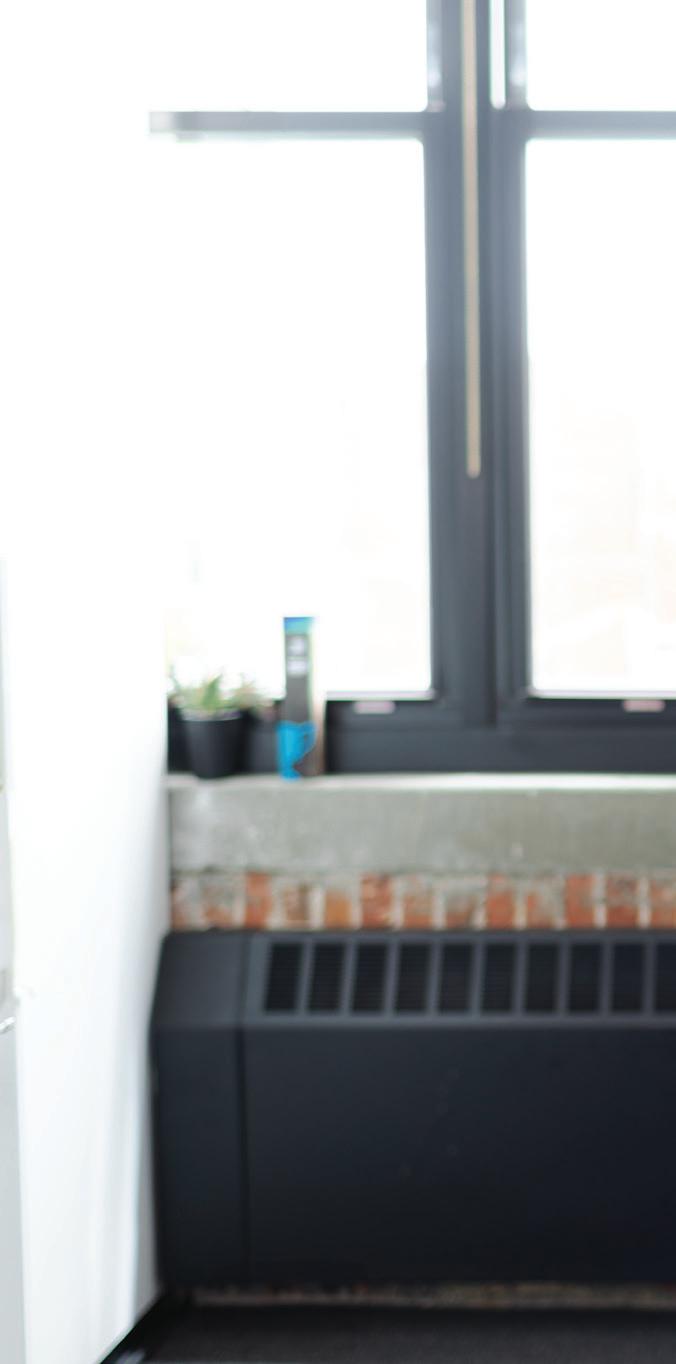

Above, a chandelier shapes 12 petals of a lotus in bloom, bathing the room in warm light; below, shorn slabs of nero marquina and crema marfil cut eight points of a rose compass, encircled by five faux-leather chairs, three windows, three portraits, and a fireplace. On the remaining wall, a smoker’s benediction:
“The world we have created or that has been created for us is a much more hectic place to live than it ever has been before, filled with stress and problems with our lives, our jobs, the economy, and the environment. We are all looking for a haven, a fortress where we can be free even momentarily from the dragons and demons that we must fight daily. The cigar has become that fortress, a sanctified place where we can regroup our internal forces. With just a single cigar, we can escape from the cares of the world, if only for an hour or so. That is the beauty of cigar smoking. That is the legacy we have inherited, and the secret to the enjoyment of life.”
One portrait features Sir Winston Churchill, the ‘puro’ jutting from his lip keeping his infamous “black dog” of bipolar disorder at bay, if only for a time. Opposite Churchill gazes Julius “Groucho” Marx, his expression clear of vaudevillian hokum, eyes pensive and probing above a smoldering Dunhill. In this hallowed space, all seem privy to “the secret to the enjoyment of life.” It’s a secret the man pictured in the third, smaller frame is keen to share and why, after 22 years, his dream of a personal “Grand Havana Room” was revived.
“When people come in here I say, ‘Which of these three photos doesn’t belong?’ That one!” quipped Jay Lerner, his self-portrait above the mantel appearing to grin an acknowledgement. “My wife made me put it up there…”
Bashfulness aside, Lerner fully credits his wife, Bobette, in conjunction with Stan How of Stanley J. How Architects, for the backyard cabana’s magnetic appeal. At just under 800 square feet, walls of unadorned limestone belie the splendor within in fact, the pull might even be too strong at times.
“Somebody said, ‘Why don’t you put in a shower?’ I said, ‘Guys stay too long now!’” he laughed.
Growing up in Milwaukee, Lerner comes from a long line of cigar enthusiasts. From his grandfather’s vegetable market to his father’s grocery store, he also carried family tradition by pursuing a career in the supermarket industry. In time, Lerner’s purview would expand to commercial development, brokerage, leasing, and management, all of which would come to fall under the umbrella of Omahabased The Lerner Company, which he founded in 1985.
As Lerner’s success grew, so did his appetite for rare cigars. Indeed, though his smoking room may be “free from dragons,” there is treasure to be found in the coils of smoke. The Grand Havana Room sports a fully stocked bar wherein premium whiskey sparkles on every shelf and of course a humidor rife with coveted blends and wrappers, including limited releases.
“Over the years, they’ll come out with special reserves, like this one,” Lerner said, the patina of polished wood and gold lettering (“Heaven and Earth Opus22”) one of just 500 boxes released in 2020 by Dominican producer, Arturo Fuente. “I tell people, ‘I don’t have a cigar smoking fetish, I have a cigar collecting fetish.”


“I SWEAR TO GOD, YOU SMOKE A CIGAR WITH A BUNCH OF GUYS OR EVEN WITH A BIG GROUP, YOU FORGET ABOUT EVERYTHING.” -JAY LERNER
We offer bulk subscriptions of our local magazine to businesses to help them express their appreciation.
A subscription to Omaha Magazine includes Omaha Home Magazine.
Benefits:
• Significant savings over individual subscriptions.
•Increase client referral and advocacy
• Customer retention program
• Show appreciation year round (8 times a year)
• Your business name and message will be on the top line of every mailing label. (Up to 36 characters)
★ BONUS
Based on this confession alone, one might assume Lerner’s decision to build his Grand Havana Room in 2021 was born of a collector’s fever and a need to expand beyond the humidor in his residence proper. In truth, the interceding decades were an exercise in self-control not a lack of it.
“When I was going to build it [in 1999], it was going to be on the other side of my house; three exterior walls and one common wall connected to the garage. And then I had a hallway that was going to come out of the garage into [the smoking room],” Lerner explained. “And then I figured, ‘I’m going to spend every night of my life smoking cigars and drinking scotch.’ So, at the last minute I took it off the plan and removed it.
“Twenty-two years later, and I said, ‘I’ve got a lot more self-discipline, so…it’s going back!’”



Each subscription includes FACES of Omaha and Best of Omaha Results issues







The addition has proved wildly popular with friends, family, and even the media. A lifelong subscriber, Lerner was honored to be featured in last year’s July/August edition of Cigar Aficionado magazine, a national publication. Still, while the intimacy and convenience of the Grand Havana Room is unmatched, Lerner continues to frequent area cigar lounges.
“We got a group called the ‘Havana Garage Mafia’ that meets every Thursday at Havana Garage downtown, and I go to Safari [Cigars and Lounge in West Omaha] too,” Lerner said. “It’s fun being with more people sometimes. If there’s a game on and everybody’s yelling around, I like doing that.”
Lerner returned to the quote on his wall, titled “I Love My Cigar” and transcribed from “The Ultimate Cigar Book” by Richard Carleton Hacker for guests to see. Though there’s much to absorb and to marvel at, he finds this passage an indispensable feature of the Grand Havana Room. It reminds visitors and himself, from time to time what it’s really all about: that the cigar is the sanctuary.
“I swear to God, you smoke a cigar with a bunch of guys or even with a big group, you forget about everything,” Lerner affirmed. “For an hour and a half if you’ve got financial problems, or you’ve got a family issue, or business [issues] for an hour and a half, you sit there and it disappears.
“You’re looking at it, you’re puffing on it, you’re smelling it and for me, that’s escape.”
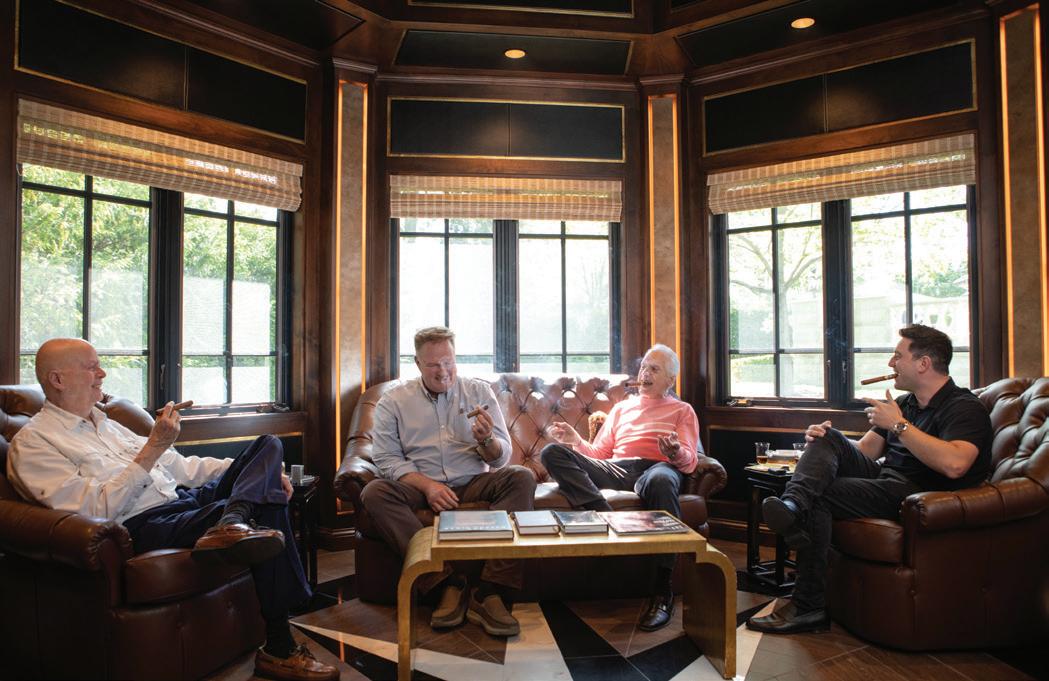

 Jay Lerner, third from left with friends
Jay Lerner, third from left with friends
 Stacee Wagner, Manager
SITZMANN
Stacee Wagner, Manager
SITZMANN
When you think about Papa Johns, one may think about the “Epic Stuffed Crust Pizza,” covered with pepperoni, delivered hot and fresh with their signature garlic dipping sauce. Or perhaps it’s their “Barbecue Chicken Pizza” or the famed “Philly Cheesesteak Pizza.” But the dollars spent at Papa Johns don’t just go toward delicious, cheesy dough they are also helping give back to the Omaha community.
Since 2019, the Papa Johns Foundation for Building Community has been handing out grants to organizations in local communities, resulting in Papa Johns awarding over $1.4 million to 270 organizations across 40 states.
In Omaha, the Papa Johns Foundation for Building Community awarded $27,500 to five nonprofit organizations in 2024. Local recipients of the grant included Food Bank for the Heartland, Boys & Girls Clubs of the Midlands, Junior League of Omaha, Completely Kids, and Banisters Leadership Academy. The goals of the grant are to promote hunger relief, food recovery that helps reduce food waste, and youth leadership.
Papa Johns franchises nominate local organizations who then apply for the grant, whose review committee then selects the recipients. The grant is annual, and organizations can apply each year. To receive the grant, organizations write an outline specifying what they will do with the money and highlighting how the programs are aligned with Papa Johns’ focus.
“THE PROGRAM REFLECTS OUR CORE VALUES, WHICH ARE: PEOPLE FIRST, DO THE RIGHT THING, AND EVERYONE BELONGS.”
-JENN GARNER, PAPA JOHNS SENIOR DIRECTOR OF CORPORATE AFFAIRS AND SUSTAINABILITY
“This program creates an impact nationwide for our franchises and it’s part of Papa Johns as a Global Brand,” said Jenn Garner, senior director of corporate affairs and sustainability at Papa Johns. “The program reflects our core values, which are: people first, do the right thing, and everyone belongs.”
Garner added that they couldn’t do this great work without the help of the franchisees. “The ‘zees’ are really the leaders in our communities. It’s been an honor for us to help support the work that they are doing to improve the lives in their local communities,” she said. “It’s great to see the impact of the funding. We get letters and photos telling us what they were able to achieve with the grant,”
Local Papa Johns franchise owner Eric Murphy and his team have been one of the larger participants in the Building Community Fund. Murphy owns and operates Papa Johns in Omaha and other markets. Murphy and his team also received the Building Community Award for their community engagement. Murphy’s team volunteered, participated in helping to direct grant funds, and delivered pizza donations. “We consider it a great privilege to be able to contribute to all of these deserving organizations the work they do
in our communities is tremendous, and we are thrilled to have been able to help in this way,” said Eric Murphy.
The Food Bank for the Heartland was awarded $7,500 from the grant. Every dollar the organization receives can provide three meals. With the Papa Johns Foundation grant, it was able to purchase 30,000 meals.
The Food Bank utilized the grant for their schoolbased mobile pantries, which are run by schools and distribute from school parking lots. Parents drive up, and volunteers load their cars loaded with fresh produce, canned goods, beans, soup, pasta, and fresh bread and baked goods. The families who receive pantry items have children attending the school and are comfortable with the people giving them the food, so it is a win-win for the community.
Stephanie Sullivan, assistant director of marketing and communications for the Foodbank for the Heartland, described the grant as a “game-changer” for the community. “It’s a wonderful opportunity to be able to help so many families access food at their school,” she said.
“What this program really does is allow families to stretch their budget so they can have money to pay for other things like rent, utilities, and medications,” she added. “It allows them access to healthy food that they might not have access to.”
CONT. PAGE 38
FROM PAGE 37
Grant funds allocated to the Boys & Girls Club of the Midlands were used to support Keystone Club for our teen members. Keystone Club is a premier leadership experience where Club members ages 14 to 18 participate in activities that champion academic achievement, career preparation, and community service. Last August, six teens who participated in Keystone Club traveled to Minneapolis, where they were able to attend a Twins baseball game and visit Mall of America, the Valleyfair Amusement Park, and a local Boys & Girls Club.
Since 1917, five generations of the Walker family have served the retail, and then the commercial, laundry markets in Omaha and the surrounding areas. We’re Dry Cleaners, but many Omaha business owners have also depended on our Uniform Rental Service since 1974.
www.maxiwalker.com & www.maxiwalkeruniform.com
B2B_MayJune_2024.qxp_Layout 1 3/12/24 10:51 AM Page 1

“BOYS & GIRLS CLUBS OF THE MIDLANDS HAS GREATLY BENEFITTED FROM COMMUNITY SUPPORT, LIKE THE GRANT WE RECEIVED FROM PAPA JOHNS. THE CLUBS RELY ON THE GENEROSITY OF OUR COMMUNITY TO ENSURE KIDS HAVE A SAFE, FUN PLACE TO GO DURING OUT OF SCHOOL TIME. WE CERTAINLY COULDN’T DO WHAT WE DO WITHOUT SUPPORT LIKE THAT FROM PAPA JOHNS.”
-RICHARD WEBB, BOYS & GIRLS CLUB OF THE MIDLANDS PRESIDENT & CEO
“Boys & Girls Clubs of the Midlands has greatly benefitted from community support, like the grant we received from Papa Johns. The Clubs rely on the generosity of our community to ensure kids have a safe, fun place to go during out of school time. We certainly couldn’t do what we do without support like that from Papa Johns,” said Richard Webb, Boys & Girls Club of the Midlands President & CEO.
Papa Johns is proud to be able to help nurture these organizations through these grants. “The work of organizations that build and empower the next generation of leaders, fight hunger, and reduce food waste is critical to our world’s future. We are proud to partner with franchise owners such as Papa Johns of Omaha to support our shared goals of building healthier, stronger communities and creating new opportunities for the people who live in them,” said Rob Lynch, president and CEO of Papa Johns.
For more information, go to www.papajohns.com/foundation/#.
B2B














A staggering 24,576 votes were cast for this year’s Omaha Metropolitan Area (OMA) Tourism Awards, marking a new record. Now in their eighth year, these awards celebrate outstanding tourism businesses across Douglas, Sarpy, and Pottawattamie counties. Drum roll please, and the winners are…
Douglas County:
Best Attraction: Winner: Omaha’s Henry Doorly Zoo & Aquarium
Runners-up: Kiewit Luminarium and Boys Town
Best Hotel: Winner: The Farnam, Autograph Collection
Runners-up: Kimpton Cottonwood Hotel and Moxy Omaha Downtown
Best Restaurant: Winner: Greek Islands Restaurant
Runners-up: Yoshitomo and V. Mertz
Best Retail:Winner: Made in Omaha
Runners-up: Prairie in Bloom and Nouvelle Eve
Sarpy County:
Best Attraction: Winner: Schramm State Park Education Center
Runners-up: Sarpy County Fairgrounds and Gifford Farm
Best Hotel: Winner: Embassy Suites by Hilton La Vista
Runners-up: Courtyard by Marriott La Vista and Hampton Inn & Suites La Vista
Best Restaurant: Winner: Sweet Rice Thai Food Express
Runners-up: Good Life Sports Bar & Grill and Luigi’s Italian Restaurant
Best Retail: Winner: Main Street Decor and More
Runners-up: Robin’s Nest and Town & Country Floral
Pottawattamie County:
Best Attraction:
Winner: Mt. Crescent Ski Area
Runners-up: Phoenix Movie Theater and Hoff Family Arts & Culture Center
Best Hotel: Winner: Holiday Inn Hotel & Suites @ Ameristar
Runners-up: Hilton Garden Inn and SpringHill Suites
Best Restaurant: Winner: Pizza King
Runners-up: Buck Snort Neola and Minden Bowl Cafe
Best Retail: Winner: The Unique Boutique Iowa
Runners-up: Bev’s Porch and The Olive Branch
If you’re unfamiliar with any of these businesses, take the opportunity to explore and find out why they were voted as this year’s favorites. The OMA Tourism Awards are presented in partnership with the Council Bluffs Convention & Visitors Bureau, Sarpy County Tourism, and Visit Omaha. For more details, go to OMATourismAwards.com.
For more information, go to visitnebraska.com/ omaha-convention-visitors-bureau.

A s the President and CEO of the Greater Omaha Chamber, I have the privilege of witnessing the tremendous impact our members have on the growth and prosperity of our region. Our 130-year strong Chamber stands as a beacon of collaboration, driven by the dedication and passion of our volunteers. I’m reaching out to invite small business owners and business leaders to deepen their engagement with our community by becoming a volunteer or supporting your employees’ growth by encouraging their participation in one of our dynamic membership programs.
Volunteering with the Greater Omaha Chamber is not just an act of service; it’s an investment in your business’ future and the future of our community. Our programs and groups, such as the Red Ribbon Crew and the President’s Club, offer unique opportunities to contribute to our vibrant business ecosystem.
The Red Ribbon Crew plays a pivotal role in celebrating business milestones. By participating in ribbon-cutting and ground-breaking ceremonies, our volunteers not only celebrate new beginnings, but also forge valuable connections. These events symbolize more than just the opening of a business; they represent the growth and resilience of our community. As a volunteer, you’ll be at the forefront of these celebrations, expanding your network and showcasing your commitment to regional prosperity.
Similarly, the President’s Club offers an extraordinary chance to shape the future of our business landscape. By recruiting new businesses to join the Chamber, you’re not only growing our membership but also strengthening
our collective voice. Participating in this group allows you to leverage your influence and insights to attract diverse enterprises, enhancing our community’s economic diversity and vibrancy.
Beyond these programs, we also offer opportunities to join YP action committees, the Employer Coalition and event planning committees, such as those for the CODE Conference, Young Professional Summit, and HIRE Conference. These platforms allow you to engage directly with issues and opportunities within your field, driving innovation and best practices.
Volunteering with the Greater Omaha Chamber is a powerful way to contribute to our collective success. It offers a unique blend of community service, networking, and professional development. By joining one of our membership programs or committees, you’ll not only make a lasting impact on our region but also gain invaluable experiences and connections that will benefit your business and personal growth.
For more information, visit omahachamber.org.
 Heath Mello is the CEO for the Greater Omaha Chamber.
B2B
Deborah Ward is the executive director of Omaha Convention and Visitors Bureau.
Heath Mello is the CEO for the Greater Omaha Chamber.
B2B
Deborah Ward is the executive director of Omaha Convention and Visitors Bureau.
















